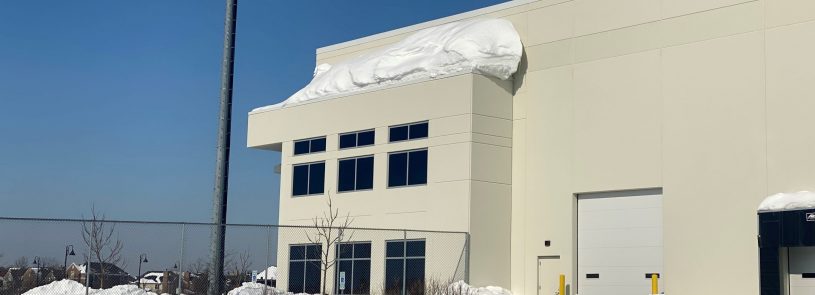Snow load: Is your roof at risk?

Snow drift from a higher roof
By Karl Pennings
| Is my roof at risk?
Is your building experiencing higher snow loads than it was originally designed for? Ask yourself:
If you answer yes to any of the above questions, it doesn’t necessarily mean your roof structure is deficient for the current code snow load provisions, but it does increase the possibility. |
While we’re used to heavy snowfall in northern areas of the country and design new buildings accordingly, some older buildings and those with known deficiencies could be at risk for snow-related failure.
As a structural engineer and member of the ASCE7 subcommittee on snow and rain loads, I see the necessity of codes that help us determine loads and design stronger buildings firsthand. To determine the snow load required in a building’s design, a practicing engineer follows these three basic steps:
- Determine the ground snow load. This number is tabulated based on the historical measurements taken at various weather stations in the U.S. In the Chicago area, where I live, the ground snow load is currently 25 pounds per square foot. However, the 2022 code cycle will update ground snow load codes to improve reliability and incorporate the last 25 years of snow load measurements.
- Calculate the uniform snow load on the roof. Some snow is blown off the roof to the ground and some is melted by heat from the roof. In general, roof snow loads are somewhere between 50-90% of the ground snow load, depending on the exposure and heat transfer.
- Calculate unbalanced snow loads caused by sliding or drifting snow. Most structural issues related to heavy snow aren’t caused by uniform snow loads. Sliding snow occurs on sloped or slippery roofs when some of the available snow can slide down onto a lower roof. Sliding snow should be accounted for on slippery roofs and when non-slippery roof slopes are 2 on 12 or greater. Though sliding snow can cause potential issues on lower roofs, the commentary to ASCE7-16 indicates that most snow load failures on roofs are caused by drifted snow. Drifted snow occurs when wind blows over a roof, picks up loose snow and deposits it against an obstruction such as a parapet or a change in roof elevation from a high to low roof. Drift heights become larger as the roof extents and ground snow loads increase. Drift loads are prescribed in a triangular shape with a 4 to 1 ratio. For a lower roof below a 200-foot-long upper roof in the Chicago area with a ground snow load of 25 psf, the code prescribes a snow drift 4’-8” tall and 18 feet wide. This additional drifted snow load is more than double the flat roof snow load that must be designed for over the same 18-foot width.
Unfortunately, most older building codes did not include drifting provisions. The current drift provisions that include roof length and ground snow load were not introduced until 1988. Because drifted snow was often unaccounted for in the design of older roofs, these buildings are most susceptible to roof damage due to snow loads.

Parapet snow drift
A physical sign of snow overload to look for is excessive deflection or sagging of the roof structure. Structural members are intended to have some flexibility with expected deflections under design snow loads of the span divided by 360 or 240. This means on a 30’ span, deflection could be somewhere between 1” and 1.5” and on a 60’ span, deflection could be 2” and 3” at the design snow load. If your building has 60’ joists supported by 30’ girders, the expected deflection would be additive or between 3” and 4.5”. If you are seeing a larger deflection than the span length ratios would predict, it could be a sign that you have more snow on the roof than it is designed for. A properly designed roof for today’s codes in the Chicago area should be able to support about two feet of uniform snow when load and safety factors are accounted for.
The ASCE 7 subcommittee on snow and rain loads is currently finalizing the changes to the Snow Load Chapter for the 2022 version of the document. Significant changes are proposed for all three snow load calculation steps identified, with changes to the ground snow load map, the factor that accounts for the heat transfer through the roof, and the equations used to determine drifted snow. I’ll address these changes and more in a future blog.
If buildings are properly designed and constructed using building codes that include modern provisions for drifting snow, the risk of snow-related failures is extremely low, provided the building roof drainage system is properly maintained. For older buildings, or those with known deficiencies, it is important to be vigilant in watching for significant accumulation in areas of the roof that may not have been accounted for in the original design.












